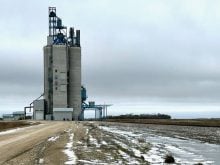REGINA — Although Ottawa is responsible for native issues, participation of the provinces is key to land claim settlements.
Each province approaches the process differently, but all the prairie provinces have control of crown land and resources within their boundaries and must be involved in negotiations for this land.
Governments and policies have changed over the years and few claims have been settled, although the pace is picking up.
Manfred Klein, federal director of specific claims in Western Canada, says between 1971 and 1991, about 40 specific claims were settled in the entire country. Since a new federal policy was put in place in 1991, the western office has already settled more than that.
Read Also

Internet of Things tapped for better emissions insights
Interconnected field sensor fleet allows better soil monitoring coverage and, hopefully, live insights on farm greenhouse gas emissions and nitrogen fertilizer application for farms.
SASKATCHEWAN
Saskatchewan is recognized as having taken the lead in trying to settle claims. As early as 1976, the province, the bands and Ottawa were negotiating. In the late Eighties the process bogged down but by 1991 was back on track.
More than half of the province’s 72 bands have entitlement claims and, in 1992, 25 of them signed a framework agreement setting out the terms of their claims. Several others already have settled or are negotiating on their own.
There are numerous specific claims as well. Some bands are completing these at the same time as their entitlement claims, said Tom Semaganis of the Federation of Saskatchewan Indian Nations.
MANITOBA
In Manitoba, 26 bands have recognized treaty land entitlement claims, said Jim Gallo, manager of land entitlement claims for the Indian Affairs regional office in Winnipeg.
Only 19, however, are negotiating settlement as a group. The rest are negotiating separately or as part of smaller groups. One band that was negotiating has now changed its position and is arguing breach of treaty in court.
Gallo said there are also a number of specific claims in active negotiation. Only one has been settled.
Most claims are being filed in northern Manitoba where there is lots of crown land available that no one else wants. But that could change.
“The south is very much like Saskatchewan,” said Gallo. “There is no crown land available of any appreciable quality and quantity.”
Farmers are leasing it, and it could be sold, but Gallo said the leases are so tight that farmers might as well have ownership.
While cattle producers, who are among the main users of southern crown lands, are not yet alarmed they are paying attention, said James Bezan, executive director of Manitoba Cattle Producers Association.
ALBERTA
Alberta has been settling treaty land entitlement claims since 1986 at the rate of one or two a year, said Ken Boutillier, executive director of land claims for Alberta Aboriginal Affairs.
About nine have been completed and Boutillier estimates 15 to 20 of the province’s 44 bands will have these types of claims. Specific claims could number as high as 70.
The province has not taken the same formula approach as Saskatchewan but prefers to negotiate each claim separately, Boutillier said. This way, issues of cost-sharing, the specific lands involved, third parties and resources are all dealt with up front.
He said the province has had a bit of luxury in that all negotiations have involved bands in the Treaty 8 area of northern Alberta, where the interests are largely industrial.
But defining the amount and location of land involved in a claim, he said, “is the preferable way to proceed. In that way everybody knows what the deal is.”
Boutillier said if claims are eventually going to be made in farming areas, it is likely the band and farmer would negotiate first and then approach government.
“Long after government negotiators have left, the band and neighbors have to live with each other,” he said.














